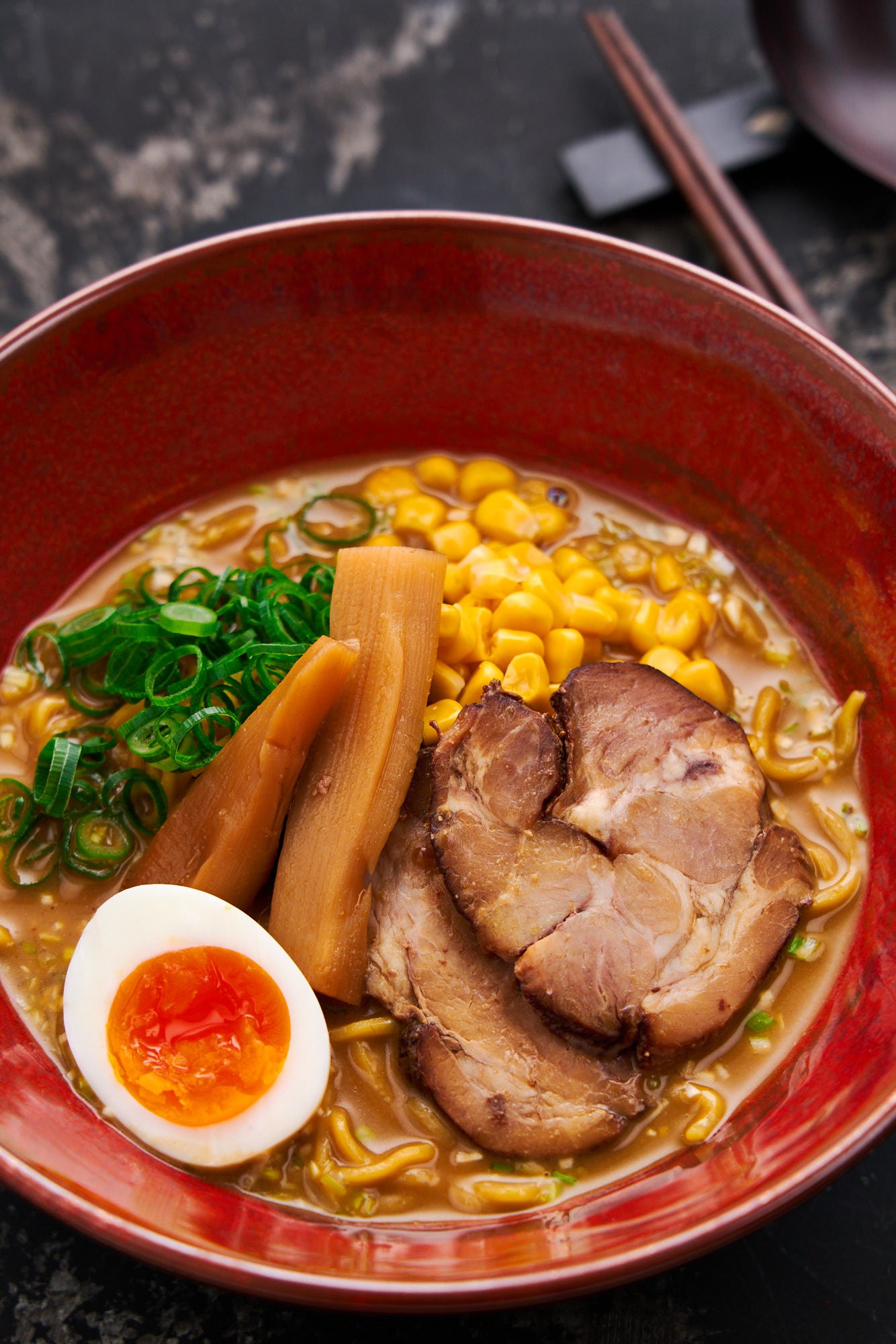
Hokkaido, in the far north of Japan, is the birthplace of miso ramen, a dish crafted to fortify against the long, unforgiving winters. After moving back to Japan in 2011, I settled in Sapporo for a few years, and these steaming bowls of soul-warming comfort helped thaw me out on even the bleakest days. Unlike a simple miso soup, Sapporo miso ramen achieves its luscious texture and depth by layering rich tonkotsu broth (pork bone) with nutty umami-packed miso. This process can take hours or even days, but I've designed an easy recipe that streamlines the process of creating the collagen-rich broth needed for an authentic bowl of ramen down to under 30 minutes.
Jump to:
Why This Recipe Works
- Caramelization and Maillard browning in the base ingredients create the flavor and umami in this miso ramen broth. Using ground pork and grating the aromatics gives these ingredients a ton of surface area to brown while allowing you to quickly transfer that flavor to the soup.
- Various types of miso paste are made using different ratios of koji, soybeans, and salt, as well as different aging times. By blending three types of miso, you can capture the range of miso flavors from deep and earthy to nutty and umami-rich to sweet and creamy.
- The thick tongue-coating mouthfeel of tonkotsu miso ramen broth (or any good bone broth) comes from rendering collagen in bones and cartilage into gelatin. Adding gelatin powder creates the same texture without cooking bones for hours.
- The rich creaminess of the broth is achieved by rendering fat from the pork and then emulsifying the fat and stock using natural emulsifiers found in gelatin, miso, and butter.

Ingredients for Miso Ramen Broth
- Ground Pork - Ground pork offers ample surface area for browning and caramelization, allowing the savory flavors to develop quickly and intensify. The smaller pieces also release their juices into the broth more effectively, infusing it with a deep, rich flavor in a short amount of time. I prefer using ground pork with a 75/25 meat-to-fat ratio because the higher fat content renders into the soup, adding a luxurious richness and depth to the broth.
- Aromatics - Every ramen chef has a preferred blend of aromatics, but for this one, I like using a blend of onion, carrot, ginger, and garlic. The onion and carrot add natural sweetness and umami, while the ginger and garlic provide flavor and a spicy warmth. Grating these ingredients significantly speeds up caramelization, allowing you to get a ton of flavor from a relatively small amount of ingredients.
- Baking Soda - Adding baking soda to the pork and aromatics raises the pH of the mixture, which speeds up caramelization and the Maillard reaction.
- Hatcho Miso - Hatcho miso is a dark, concentrated miso made without grains and aged for at least two years. Browning it with the aromatics enhances its earthy depth and complexity. If you can't find Hatcho miso, you can substitute ½ tablespoon of red miso here.
- Red Miso - Red miso is aged longer than white miso and has a rich nutty flavor and robust umami. It's the flavor that most people associate with miso, and it's why I add the most. I used Hikari's Organic Red Miso.
- Saikyo Miso - Also known as Shiromiso, it has a high percentage of rice koji and is only aged for a few weeks, giving it a sweet, fresh flavor while giving the soup a creamy mouthfeel.
- Chicken Stock - Forms the base of the miso ramen broth, offering a savory backbone. For a vegetarian option, try kombu and shiitake stock.
- Powdered Gelatin - Tonkotsu miso ramen gets its velvety mouthfeel by simmering bones for hours. This breaks down the collagen into gelatin and the boiling action emulsifies the soup with the fat released from the marrow. Adding powdered gelatin eliminates the need to boil bones and the soup can be emulsified using a hand blender.
- Butter - This is optional, but I like emulsifying a pat of cultured unsalted butter into miso ramen soup to make it more rich and creamy.
- Ramen Noodles - Sapporo-style ramen usually uses moderately thick, curly yellow noodles, but any alkaline noodle you can get your hands on will work.

Miso Ramen Toppings
- Chashu - Chashu is made by braising a fatty cut of pork in soy sauce and other seasonings and is the most popular topping for ramen. I also have a chicken chashu recipe that works well here. You could also substitute Kakuni, another type of braised pork.
- Ajitama - Ajitsuke tamago (literally "flavored egg") is a popular topping. I also have a white ramen egg recipe if you don't want your egg to turn brown.
- Spicy miso - This will add a spicy kick to your noodles. Depending on how much you plan to add, reduce the amount of red miso to avoid making the broth too salty.
- Scallions - Chopped green onions make any bowl of ramen more colorful and delicious. I like to thinly chop the greens into rings, while I prefer mincing the stems (white part).
- Menma - Menma is made from fermented bamboo shoots and has a unique, resilient, crunchy texture. When used as a ramen topping, it's usually simmered in soy sauce and broth to season it.
- Corn - This is a bit of a controversial topping as it's a popular perception in Japan that miso ramen is always topped with corn. When I lived in Sapporo, the only places that put corn on their bowls were shops catering to tourists. It may have been popular historically, and the locals have moved on, but it's definitely not a required topping.
- Butter - Some places add butter as a topping for their miso ramen, but I prefer emulsifying it straight into the soup to add richness without making it greasy.
- Other Toppings - I've also seen a variety of other vegetables used as toppings for Japanese miso ramen such as bean sprouts, wood ear, garlic chives, and cabbage. For spices, white pepper, black pepper, rayu (chili oil), and ground sesame seeds are all popular options.

How to Make Miso Ramen
To build the foundation for the broth, add the vegetable oil and ground pork to a large deep skillet and grate the onion, carrot, ginger, and garlic into the pan. Using a scale to measure the ingredients speeds things up while allowing you to avoid dirtying measuring spoons and cups.
Put the pan over medium-high heat and add the Hatcho miso and baking soda, using the side of a spatula to crumble the pork as it browns. The goal is to create more surface area for the pork to brown while developing a thick layer of golden brown fond on the bottom of the pan.
Next, deglaze the pan with sake, scraping up all the browned bits that hold concentrated flavor. Pour in chicken stock and stir in powdered gelatin, which gives the miso ramen broth its signature silky texture. Bring it to a boil and turn down the heat to let the soup stock simmer gently, allowing the flavors to meld for ten minutes.
Strain the broth to remove the solids. The meat has done its job, so you can discard it or save it for recipes like meat sauce or fried rice. Add the red miso, Saikyo miso, and butter, and use an immersion blender to emulsify the broth until it's smooth and creamy. Keep the broth warm over low heat, but don't boil it.
Cook the ramen noodles according to the package directions. If the directions include a range of time, pick the lower time as the noodles will continue to cook while you garnish the bowl with toppings. Drain the noodles thoroughly to prevent excess water from diluting the miso ramen soup, and divide them between two bowls. Ladle the steaming broth over the top.
Customize your bowl of noodles with toppings like chashu, ramen eggs, menma, scallions, or sweet corn for added flavor and texture, and serve immediately.
More Quick Ramen Recipes
Since developing this easy, fast method of making deeply-flavored ramen broth for my Tsukemen Ramen, I've used it to create a recipe for Shoyu Ramen as well, and I've shaved the time down to 20 minutes! So if you enjoyed this recipe, be sure to check those out as well.
📖 Recipe

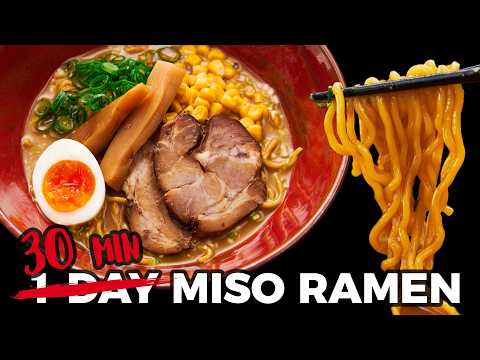
Units
Ingredients
- 1 tablespoon vegetable oil
- 230 grams ground pork (75/25 meat to fat ratio)
- 30 grams onion
- 25 grams carrot
- 25 grams ginger
- 20 grams garlic
- 1 tablespoon Hatcho miso
- ¼ teaspoon baking soda
- 2 tablespoons sake
- 4 ½ cups chicken stock
- 10 grams powdered gelatin
- 4 tablespoons red miso
- 1 tablespoon Saikyo miso (aka Shiromiso)
- 1 tablespoon cultured unsalted butter
- 230 grams fresh ramen noodles
Instructions
- Add 1 tablespoon vegetable oil and 230 grams ground pork to a large deep skillet, set it on a scale, and zero it out.

- Grate 30 grams onion, 25 grams carrot, 25 grams ginger, and 20 grams garlic into the pan, zeroing out the scale between each ingredient.

- Add 1 tablespoon Hatcho miso and ¼ teaspoon baking soda to the pan and put it on the stove over medium-high heat. Use a spatula to crumble the pork as it cooks. The smaller you can get the crumbles, the more surface area it will have, which means the more flavor you can develop.

- Continue crumbling and frying the mixture until the meat is well browned and you have a thick layer of brown fond on the bottom of the pan (be careful not to burn it). This will take about 8 minutes.

- Add 2 tablespoons sake and scrape up the fond from the pan, then add 4 ½ cups chicken stock and 10 grams powdered gelatin. Stir the mixture together, continuing to scrape any flavor stuck to the pan, and bring the mixture to a rolling boil.

- Reduce the heat to a simmer and cook the ramen broth for 10 minutes.

- Strain the soup, pressing on the solids to get as much of the liquid out of them as you can.

- Add 4 tablespoons red miso, 1 tablespoon Saikyo miso, and 1 tablespoon cultured unsalted butter to the broth, and use an immersion blender to emulsify the soup.

- Pour the miso ramen broth into a pot and keep it warm over low heat. Be careful not to let this boil.

- Boil 230 grams fresh ramen noodles according to the package directions. Drain and shake the strainer using a downward motion to force out any excess water.

- Divide the noodles between two bowls and cover with soup.

- Garnish the ramen with your favorite toppings such as chashu, a ramen egg, menma, scallions, and corn.

Nutrition Facts
FAQ
Miso ramen is a Japanese noodle soup with a rich, creamy broth made with miso paste, giving it a nutty, umami-packed flavor. Originating in Sapporo, it includes yellow curly alkaline noodles and is often topped with chashu (braised pork), menma (fermented bamboo shoots), and scallions.
Miso Ramen is a 4-syllable name pronounced as follows (read the italicized parts).
mi like meat
so like sore
ra- the “ra” sound does not exist in the English language, and the best way to make it is to say the word "romp" with the tip of your tongue at the front of your mouth. The "-" extends the vowel.
men like mental
At its core, ramen broth is made from a blend of soup stocks (pork, chicken, fish, shellfish, etc) seasoned with taré (a seasoning mix). The most common types of taré are shoyu (soy sauce), miso, and shio (salt). The broths can be mixed and matched with taré to create many different types of ramen, such as Tonkotsu Miso (pork bone broth with miso) and Gyokai Shoyu (seafood with soy sauce).
This ramen recipe can easily be made spicy by adding your favorite Asian hot sauce, chili paste, or chili oil. I do not recommend using an American-style hot sauce as it will make your ramen sour.
Some miso ramen (including this recipe) has butter, but it's optional. Otherwise, traditional miso ramen does not include milk or cream and definitely does not include coconut milk.

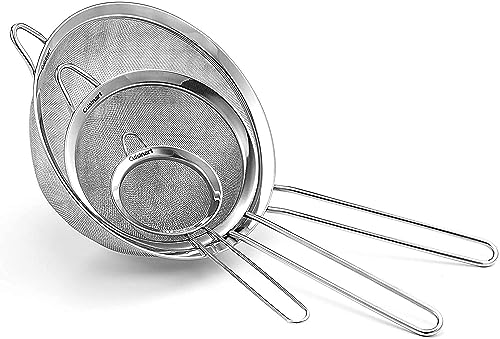
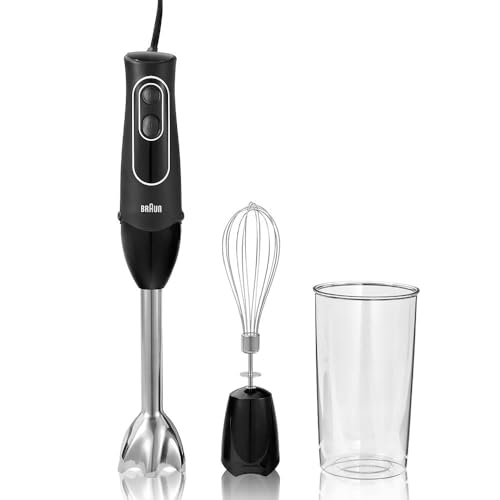

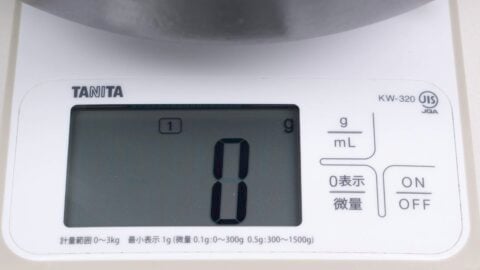

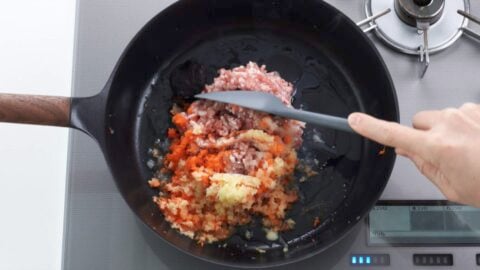
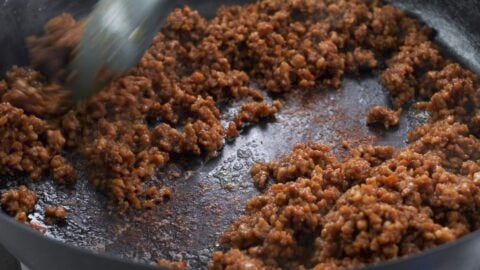

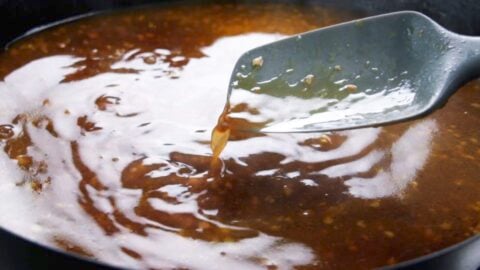
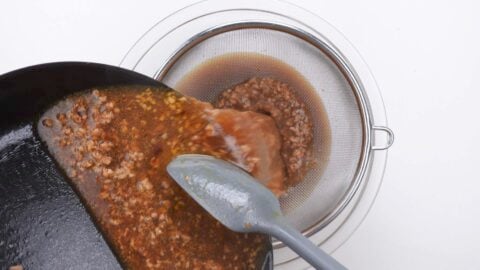
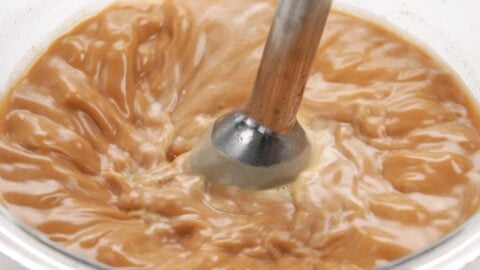


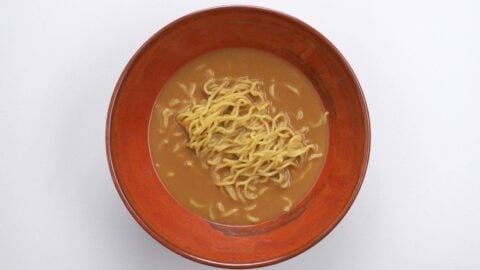
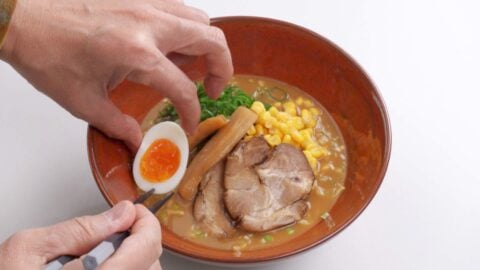
Leigh says
This is brilliant! I can't wait to try it. Do you have any thoughts on whether collagen would work like gelatin to create the proper mouth feel?
Marc Matsumoto says
Thanks Leigh, collagen is a protein that creates structure for bones, joints, tendons, and ligaments. It is water insoluble. When you apply heat to collagen, it breaks down into gelatin, which IS water soluble. I'm not sure what form you have collagen in, but if it's in its natural form it will not melt into the soup and you'll need to cook it for quite a while to transform it into gelatin first.